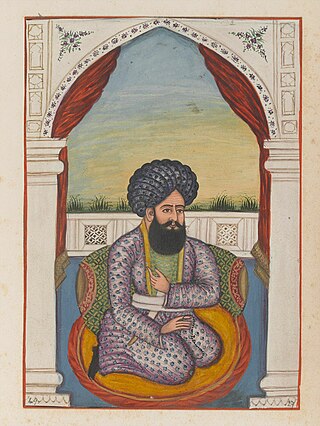
Khawaja Syed Muhammad Nizamuddin Auliya, also known as Hazrat Nizamuddin, Sultan-ul-Mashaikh and Mahbub-e-Ilahi, was an Indian Sunni Muslim scholar, Sufi saint of the Chishti Order, and is one of the most famous Sufis from the Indian Subcontinent. His predecessors were Fariduddin Ganjshakar, Qutbuddin Bakhtiyar Kaki, and Moinuddin Chishti, who were the masters of the Chishti spiritual chain or silsila in the Indian subcontinent.

Sayyid is an honorific title of Hasanid and Husaynid lineage, recognized as descendants of the Islamic prophet Muhammad through his daughter Fatima and Ali's sons Hasan and Husayn. The title may also refer to the descendants of the family of the Bani Hashim through the Prophet’s great-grandfather Hashim, and others including Hamza, Abbas, Abu Talib and Asad ibn Hashim.

Lohri is a popular winter Dogra and Punjabi folk festival celebrated primarily in Northern India. The significance and legends about the Lohri festival are many and these link the festival to the Duggar region and Punjab region. It is believed by many that the festival marks the passing of the winter solstice. Lohri marks the end of winter, and is a traditional welcome of longer days and the sun's journey to the Northern Hemisphere. It is observed the night before Maghi.

Bhati is a Rajput clan that claims descent from a 3rd-century monarch, named Rao Bhati. The Bhati clan historically ruled over several cities in present-day India and Pakistan with their final capital and kingdom being Jaisalmer, India.

The Hazrat Nizamuddin Dargah is the dargah and mosque complex of the Sufi saint Nizamuddin Auliya, located in the Nizamuddin West area of Delhi, India. The dargah, or mausoleum, is a Sufi shrine and is visited by thousands of pilgrims every week. The site is also known for its evening qawwali devotional music sessions.

Sandal Bar, also known as the Jungle Bar, is the section of the Bar region in western Punjab located between the rivers Ravi and Chenab, and comprises the southern part of Rechna Doab. It corresponds to the present-day Faisalabad, Jhang, Toba Tek Singh and Chiniot districts.
Rai Abdullah Khan Bhatti popularly known through his moniker Dulla or Dullah Bhatti, was a Punjabi folk hero who led a revolt against Mughal rule during the reign of Emperor Akbar. He is entirely absent from the recorded history of the time, and the only evidence of his existence comes from Punjabi folk songs.

Mirzā Mazhar Jān-i Jānān, also known by his laqab Shamsuddīn Habībullāh, was a renowned Hanafi Maturidi Naqshbandī Sufi poet of Delhi, distinguished as one of the "four pillars of Urdu poetry." He was also known to his contemporaries as the sunnītarāsh, "Sunnicizer", for his absolute, unflinching commitment to and imitation of the Sunnah.

Chausath Khamba, also spelled Chaunsath Khamba, is a tomb built during 1623–24. It is located in Nizamuddin precincts of Sufi Muslim shrines and tombs in New Delhi, India. The name means "64 pillars" in Urdu and Hindi. It was built by Mirza Aziz Koka, son of Ataga Khan, as a mausoleum for himself, at the time when Mughal Emperor Jahangir ruled from Delhi. Mirza Aziz Koka had served several times as Jahangir’s Governor of Gujarat before he died in Gujarat.

Qadiriyya wa Naqshbandiyya is a Sufi order which is a synthesis of the Qadiri and Naqshbandi orders of Sufism. The Qadiriyya wa Naqshbandiyya Sufi order traces back through its chain of succession to Muhammad, through the Hanbali Islamic scholar Abdul Qadir Gilani and the Hanafi Islamic scholar Baha al-Din Shah Naqshband, combining both of their Sufi orders. The order has a major presence in three countries, namely Pakistan, India, and Indonesia.
Jangpura is a neighbourhood in South East Delhi district of Delhi. Beginning from the east and moving clockwise, it is bordered by the Mathura Road, Ring Railway line, Silver Oak Park beyond the Defence Colony Flyover, and the Barapulla Nullah. It encompasses the residential areas of Jangpura A and B on either side of the Mathura Road, Jangpura (Bhogal) extending west from the Mathura Road until Jangpura Extension, which in turn extends along the northern side of the Ring Railway line to the east side of the Defence Colony Flyover on Josip Broz Tito Marg. The small colony of Pant Nagar along the Barapulla Nullah is contiguous with Jangpura Extension.

Punjabi folk music is the traditional music on the traditional musical instruments of the Punjab region of the Indian subcontinent. There is a great repertoire of music from the time of birth through the different stages of joy and sorrow till death. The folk music invokes the traditions as well as the hardworking nature, bravery and many more things that the people of Punjab get from its gateway-to-India geographical location. Due to the large area with many sub-regions, the folk music has minor lingual differences but invokes the same feelings. The sub-regions, Malwa, Doaba, Majha, have numerous folk songs. Punjabi dance OP Bhangra music which is a genre of Punjabi modern music invented in Britain by the Punjabi diaspora.

Ghawth SayyidMir Jan Shah Saheb ibn Hasan Naqshbandi Ishaani was a Sufi saint from Kabul and a 19th century leader of the Naqshbandi Ishaani Sub-Tariqa.

Sultan Mohammad Khan, also known as Ghazi Sardar Sultan Mohammad Talaei, and known by his epithet, Sultan Mohammad Khan the Golden was an Afghan chief minister and regent. He was a powerful half-brother of Emir Dost Mohammad Khan, the eventual ruler of Afghanistan who seized control of Kabul from him. Prior to and during the reign of Dost Mohammad Khan, Sultan Muhammad Khan Telai was chief minister and governor of various regions of Afghanistan, including Kabul, Peshawar and Kohat. He was the first of the Musahiban, a Mohammadzai dynasty that began with him and ruled Afghanistan for more than 150 years, in various forms such as emir, king or president from 1823 to 1978.

Sayyid Mahmud Agha was a Sufi from South Asia. He was the brother of Sayyid Mir Jan and acted under him as a saint of the Naqshbandi Sufi order. Together with his brother, he preached the teachings of their ancestor Khawand Mahmud, known by his followers as Hazrat Ishaan.
Sayyid Ali al-Akbar ibn al-Hasan was a Sunni Muslim saint, and according to some historians of genealogy the second son of Imam Hasan al-Askari, the eleventh Imam in Shia Islam. He was also the brother of the twelfth Imam Muhammad al-Mahdi. His existence was hidden because of contemporary political conflicts with the political leadership of the Abbasids, reaching its peak at that time.

Khwaja Muin-ud-Din Al- Naqshbandi Al-Kashmiri commonly known as Moinuddin Hadi Naqshband, was a 17th-century Sufi saint from Bukhara and a direct descendant of Baha al-Din Naqshband. He succeeded his father, Hazrat Ishaan in the Naqshbandi Ishaani Silsila within the Naqshbandi Sufi order.
Sayyid Mir Fazlullah Agha was a Sunni Saint and the Chief Justice of the Emirate of Afghanistan. He was a member of the Naqshbandi Sufi order.
Mir Sayyid Hasan ibn Azimullah was an Emir of a group of Sunni Sayyids of Khorasan, belonging to the Naqshbandiyya order. His descendants were confirmed as Emirs of the Afghan Sayyids and custodians of the Hazrat Ali Shrine by the Muhammadzai Royal Dynasty.











